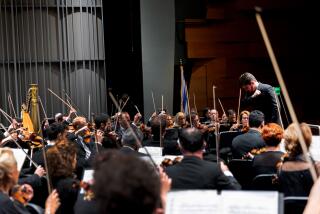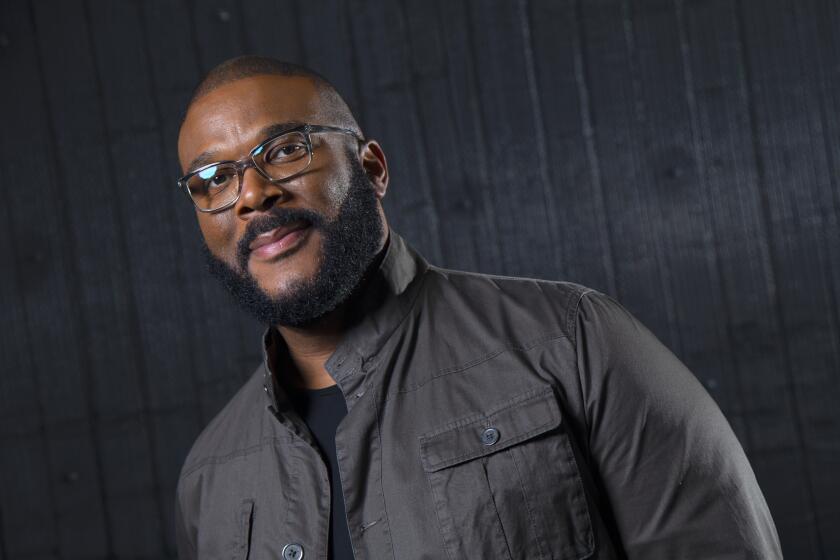Enigmatic Mocking From Shostakovich
- Share via
Not all of Shostakovich’s music is weighted with enigmatic allusions to extra-musical events. You do not need the composer’s biography to enjoy, for instance, his First Piano Concerto (1933), which, while its mocking can’t be certified as good-natured, is above all a sophisticated, accessible entertainment: part raucous display-piece, part romantic idyll. Or is it a satire of a romantic idyll? With Shostakovich, you never know.
The 26-year-old’s First Concerto--suddenly we’re being bombarded with this work by the recording companies--enlists a dashing, hammering, tickling solo piano, a trumpet co-soloist given some memorably lip-cracking licks and an orchestra whose brilliant scoring nonetheless is restricted to strings.
As part of an oddly constructed showoff program, Peter Jablonski, a 22-year-old Swede, is somewhat hampered in strutting his obviously strong stuff, as is trumpeter Raymond Simmons, by Vladimir Ashkenazy’s earthbound conducting of a string contingent from London’s Royal Philharmonic (London 436 239).
Jablonski is further employed in Rachmaninoff’s “Paganini” Rhapsody (yawn) and, most gainfully, in Lutoslawski’s brief, perky set of variations on the same Paganini theme.
A wittier, more loose-jointed protagonist, one Ronald Brautigam, is featured in the same Shostakovich score, also on the London label (433 702).
Brautigam is given an airily bright, finely crafted accompaniment by the strings of the Royal Concertgebouw Orchestra under Riccardo Chailly, with Peter Masseurs as the snappy co-soloist.
Here the Concerto is presented as part of a Shostakovich program titled “Jazz Music,” although the jazz associations of this work and the tepid second of two the composer called “Jazz Suites” prove elusive.
The first Jazz Suite (1934), however, is a delectable morsel, its smarmy saxophone solos and Hawaiian steel guitar riffs bringing to mind not the symphonic jazz of Gershwin, Ravel and Milhaud but the 1920s German cabaret style of Kurt Weill.
Included as well is “Tahiti Trot,” Shostakovich’s klutzy 1938 arrangement of Vincent Youmans’ “Tea for Two” in a commendably nimble reading from the Concertgebouw players.
Pianist Elisabeth Leonskaja is rather too serious a proponent of the First Concerto, in partnership with trumpeter Gary Bordner and the Saint Paul Chamber Orchestra under Hugh Wolff’s direction (Teldec 73282).
The accompanying material is, however, valuable: the rarely encountered Shostakovich Second Piano Concerto (1957), long regarded as problematic--that is, how seriously are we to take its schmaltz? And, as distinct from similar episodes in the First Concerto, are its dizzying runs and motor rhythms fatuously childish or satires of Soviet simplism.
Far be it from this listener to enter that fray. It, too, is a clever-sounding piece although more mild-mannered and harmonically straightforward than its predecessor.
Leonskaja and company play it neatly, if still without the last degree of spiritedness. The pianist seems most at home in the generous filler, Shostakovich’s dark and moving Second Sonata of 1942.
If you really wish to hear how both concertos should go, listen to the composer-pianist’s own performances in their first CD appearances (EMI 54606, mid-price), where he is backed with stunning panache and precision by the French National Radio Orchestra under Andre Cluytens, with Ludovic Vaillant’s spectacularly racy trumpeting in No. 1.
The rhythmic bite, the gleeful abandon of the composer’s own interpretations is hardly approached by the present competition.
In addition to the two concertos, Shostakovich plays--imposingly--several of his solo piano pieces, including the tremendous final component (No. 24) of the Opus 87 Preludes and Fugues.
It might be noted, too, that the recorded sound in both concertos--late-1950s mono--has a thrusting immediacy in EMI’s splendid transfers that the more refined sonics of the recent editions fail to project.
More to Read
The biggest entertainment stories
Get our big stories about Hollywood, film, television, music, arts, culture and more right in your inbox as soon as they publish.
You may occasionally receive promotional content from the Los Angeles Times.










